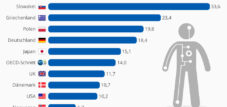Published on: March 31, 2025 / update from: March 31, 2025 - Author: Konrad Wolfenstein

Artificial intelligence shock for India: India's economic miracle in danger? AI threatens millions of jobs - picture: xpert.digital
Bernstein report warns: AI threatens India's economic growth
AI shock for India: India's economic miracle in danger? AI threatens millions of jobs
The rise of artificial intelligence threatens to transform India's demographic advantage into an economic disadvantage. A new report by the US investment bank Bernstein questions the long-cherished narrative of the Indian economic miracle. Around 500 million young Indians and Indians between the ages of five and 24 will be pushing to the labor market in the next two decades. However, while this “demographic dividend” was previously considered a guarantee of economic growth, AI could destroy this supposed advantage by taking over numerous jobs more efficiently and cheaper than human workers.
Suitable for:
- EU-India-free trade agreements-opportunities and advantages for German companies-ambitious agreements for 2025 planned planned
The concept of the demographic dividend and its importance for India
The demographic dividend denotes economic growth potential that arises when the proportion of the employable population increases in relation to non-acceptable persons (children and the elderly). For India, this means specifically: Demographic change drops the birth rate and changes the age structure of society in favor of a growing employment population. In contrast to China, whose workforce potential is already starting to shrink, India's workers' reservoir will increase until around 2030.
In theory, this development should bring several economic advantages: the wide range of young workers keeps wage increases in a moderate setting, while increased tax revenue increase the potential for investments. At the same time, the dependency relationship changes- employees have to provide relatively fewer old and children, which increases the savings rates and increases investment and consumption options.
For a long time, this demographic dividend was considered India's largest economic trump card. The forecasts were optimistic: According to current estimates, India could overtake the United States in 2039 and move up to China to the second largest economy.
AI hits the nerve of the Indian economy
The amber report is now fundamentally questioning these optimistic forecasts. Particularly alarming: the AI hits the sectors that have previously been considered India's economic strength-the service sector with IT outsourcing, business process management and knowledge work. Over ten million people work in these areas, many of them are 25 percent of the country.
The fundamental problem: AI solutions can already do many of these tasks with higher precision and speed-and this at a fraction of the costs of Indian professionals. In contrast to automation in industry, switching to AI requires little investments, which accelerates change. The amber analysis urgently warns: "The advance of AI threatens to destroy all the advantages of India's demographic dividend".
Even at the lower end of the labor market, simple activities such as elevator guides, parking guards or toll staff could be replaced by AI systems. Industry as a possible way out? Currently, only twelve percent of the Indian population in the manufacturing trade-India is still in its infancy in this area, according to the Bernstein report.
The Indian innovation paradox in the AI age
What observers could describe as “innovation paradox” is particularly worrying: India has globally one of the highest rates of AI skills among specialists and houses thousands of AI startups-but this is hardly reflected in relevant patents. India only registers 0.2 percent of all worldwide AI patents, while China 61 percent and the United States can record 21 percent for itself.
The amber analysts attribute this gap to a wrong strategy: while China consistently developed its own alternatives to Western technology-from microblogging to electric cars to AI models-India simply used western platforms. "India has not put on" foreigners, "developing their own in the Internet age - and now it is too late," is the tough judgment.
This development is underlined by current successes by Chinese AI companies such as Deepseek, whose AI model R1 exceeded many western competitors in terms of performance-and at a fraction of the costs. The company is already working on a successor model R2 that is scheduled to come onto the market this spring.
India's labor market problems in a global context
The challenges of AI affect not only India. Global studies show that developed economies are also about massive upheavals. In Germany, according to a McKinsey study, up to three million jobs (seven percent of the total employment) could be affected by a AI-related change by 2030.
An important difference: While social security systems and retraining programs can cushion the transition in industrialized countries, comparable mechanisms are missing in India for a large part of the population. In addition, there is a blatant mismatch between training and work reality: 70 percent of university graduates and 42 percent of academics work below their qualification level. AI should further tighten this problem.
Another disturbing difference: In western countries, significantly higher salaries are offered for advertised areas with AI knowledge-25 percent more in the USA. In India, on the other hand, comparable financial incentives for AI specialists are missing, which could accelerate the emigration of talents.
Suitable for:
- Search engine optimization in India decrypted: effective SEO strategies-as they conquer Indian cities and regions
Structural problems of the Indian economy
The challenge of AI meets an Indian economy that is already fighting with structural problems. The previous economic growth has not led to a proportional increase in employment. Since 2007, the number of employees in India has even declined slightly, especially for women in rural areas.
The structure of the Indian economy is changing too slowly: the service sector drives up to economic growth, but only employs 22 percent of the work capable. The labor -intensive industrial sector has not grown strongly enough to meet the increasing need for jobs. The proportion of people with regular income is still low at 16 percent.
The Indian government faces the challenge of creating the right framework that promotes workplace growth. This includes the expansion of the infrastructure, the improvement of educational and health systems, increasing productivity in agriculture, combating corruption and the new regulation of the labor market.
The future perspective: from the forward model to the warning example?
India runs the risk of becoming a warning example from the forward model. The demographic advantage, which has long been celebrated as a growth engine, could turn into a social and economic mortgage. The central question is: Can the country keep up with the pace of the AI revolution-or does it lose the connection to the future?
In order to master the challenges, India would have to invest massively in its own AI research and development, reform its education system and develop a AI strategy that takes into account the unique demographic situation of the country. Specifically, this means: Promotion of AI innovations that are complementary to human work and do not primarily aim at work.
At the same time, Indian politics has to find new ways to use the demographic dividend in the AI age. This could include promoting sectors that are less susceptible to AI automation, such as personal services, creative industries or sustainable agriculture.
A wake -up call for India's economic policy
The warning of amber analysis is an urgent wake-up call for India's economic policy. The demographic dividend-once seen as the greatest economic advantage-could turn into a demographic stress through the AI progress.
The challenge is huge: 500 million young people need productive employment opportunities in a world of work in the next two decades that will increasingly be shaped by AI. The previous equation “more young people = more jobs = more growth” no longer works automatically. India has to fundamentally rethink its economic strategy and find its own position in the global AI landscape-otherwise the demographic dividend threatens to fizzle out before it could develop its full effect.
Suitable for:
Your global marketing and business development partner
☑️ Our business language is English or German
☑️ NEW: Correspondence in your national language!
I would be happy to serve you and my team as a personal advisor.
You can contact me by filling out the contact form or simply call me on +49 89 89 674 804 (Munich) . My email address is: wolfenstein ∂ xpert.digital
I'm looking forward to our joint project.













